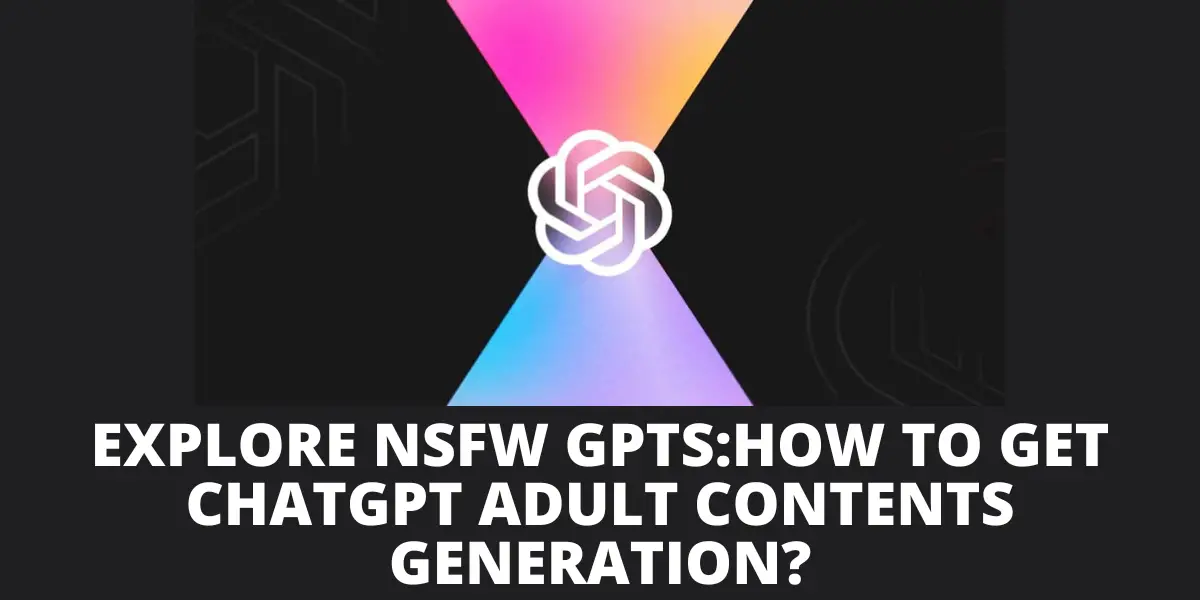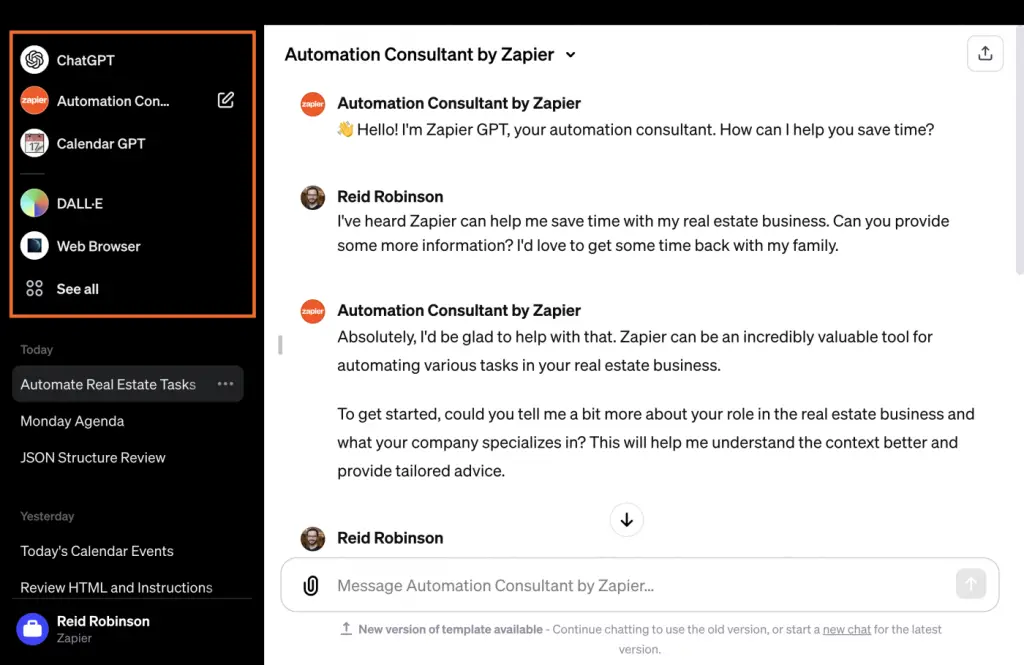Explore NSFW GPTs:How to Get ChatGPT Adult Contents Generation?

The landscape of artificial intelligence is evolving at a breakneck pace, and at the forefront of this revolution are Generative Pre-trained Transformers (GPTs). With the introduction of ChatGPT, content generation has taken a quantum leap forward. This article delves into the world of NSFW GPTs, highlighting their capabilities, differences from previous iterations, and their potential to reshape the AI industry.
Table of Contents
What is GPTs?
Generative Pre-trained Transformers, commonly known as GPTs, are at the cutting edge of artificial intelligence technology. They are a series of sophisticated machine learning models developed by OpenAI, which have the remarkable ability to generate text that closely mimics human writing. The ‘pre-trained’ aspect of GPTs is crucial; it refers to the extensive training on a diverse corpus of text data from the internet before they are ever put to task-specific use. This pre-training equips GPTs with a broad understanding of language, context, and even certain aspects of human knowledge.
The latest in this series, such as GPT-4, are not just incrementally better than their predecessors; they represent a significant leap forward. These models have been trained on even more data and fine-tuned to understand context and nuance to a degree that was previously unattainable. They can engage in a wide array of tasks, from writing essays to coding, without needing explicit instructions for each specific task. Instead, they use the knowledge gained during pre-training to generate appropriate and relevant content based on the prompts they receive.
What's the Difference Between GPTs and ChatGPT?
The Specialization of ChatGPT
ChatGPT, on the other hand, is a specialized application of GPT technology. It is a variant that has been fine-tuned further to excel in generating conversational text. While GPTs in general can produce any form of text, ChatGPT is specifically optimized for dialogue. This optimization involves additional training that focuses on back-and-forth exchanges, enabling the model to produce responses that are coherent, contextually relevant, and conversational. It’s akin to teaching an already intelligent being the art of conversation.
The difference between GPTs and ChatGPT can be likened to the difference between a Swiss Army knife and a scalpel. While the former is a multi-tool designed for a wide range of applications, the latter is a specialized instrument honed for precision in a specific task. ChatGPT is the scalpel of conversation in the AI world, designed to interact with users in a way that feels natural and human-like.
Fine-Tuning for Customization
Developers and businesses can take the base GPT model and fine-tune it to create their own version of ChatGPT. This process involves training the model on specialized data that reflects the kind of interactions it will have. For example, a business might fine-tune ChatGPT on customer service exchanges to create a virtual assistant that can handle inquiries and provide information as if it were a human customer service agent.
The fine-tuning process is not just about feeding the model more data; it’s about teaching it the subtleties of a particular domain or type of interaction. This could include industry-specific jargon, the tone of voice appropriate for a brand, or the rhythm of a conversation typical in certain cultures.
The Impact of GPTs and ChatGPT
The distinction between GPTs and ChatGPT is significant because it highlights the versatility and adaptability of AI. GPTs provide a powerful foundation, a generalist capable of many tasks. ChatGPT showcases how this foundation can be built upon to create an AI that excels in the art of conversation, providing a more engaging and human-like interaction. This is not just a technical achievement; it’s a step towards AI systems that can understand and interact with us in ways that are more intuitive and natural, making technology more accessible and useful for everyone.
In summary, while GPTs are the broader technology enabling a wide range of text generation tasks, ChatGPT is a fine-tuned incarnation that specializes in conversational engagement. Both are transformative in their own right, pushing the boundaries of what’s possible in the realm of AI and content creation.

How to Make NSFW GPTs in ChatGPT?
Creating custom NSFW GPTs within the ChatGPT framework is a transformative process that tailors the AI’s capabilities to specific tasks or industries. This customization is essential for businesses and developers who wish to leverage the power of GPTs for particular NSFW applications, such as creating a virtual assistant for AI sexting, a chatbot as girlfriend, or a conversational partner for any requirements.
The Fine-Tuning Process
Fine-tuning is the cornerstone of creating a specialized NSFW GPT within ChatGPT. It involves the following steps:
- Data Collection: Gather a dataset that is representative of the desired interactions. For an NSFW chatbot, this might include transcripts of NSFW chats or live photos.
- Data Preparation: Prepare the dataset for training. This often involves cleaning the data, ensuring it’s formatted correctly, and sometimes anonymizing it to remove sensitive information.
- Model Training: Use the prepared dataset to train the GPT model. During this phase, the model learns from the specific examples provided, adjusting its parameters to better predict and generate responses that fit the new context.
- Evaluation and Iteration: After training, the model’s performance is evaluated. If the output is not satisfactory, the model may be retrained with adjusted parameters or an enhanced dataset.
- Deployment: Once the model performs well on the evaluation metrics, it’s deployed to the intended environment, ready to interact with users.
Customization and Personalization
The fine-tuning process allows for a high degree of customization. Developers can control the tone, style, and knowledge base of the GPT by carefully selecting the training data. This means a GPT fine-tuned on legal documents will have a formal tone and use legal jargon, while one trained on casual blog posts will have a more relaxed and conversational style.
How to Generate Adult Contents with NSFW GPTs?
Once a NSFW GPT has been fine-tuned and deployed within ChatGPT, generating content with it becomes a matter of interaction between the user and the AI. Here’s how users can generate different types of content:
Generating Written Adult Content
- Prompt Crafting: Begin with a clear and concise prompt that outlines the content’s purpose, audience, and style. The more detailed the prompt, the more aligned the output will be with the user’s expectations.
- Content Generation: Submit the prompt to the GPT. The AI will generate a draft based on the prompt and its training.
- Review and Refine: Evaluate the generated content. If it requires adjustments, refine the prompt and ask the GPT to generate a new version.
Generating Interactive Adult Content
- Interactive Prompts: For interactive content, like a AI sex chatbot, prompts should be designed to encourage a back-and-forth dialogue.
- Dialogue Generation: Engage with the GPT in a conversational manner, providing it with user inputs and using the AI’s responses to guide the conversation.
- Dynamic Refinement: Continuously refine the dialogue based on the GPT’s responses to steer the conversation in the desired direction.
Generating Creative Adult Content
- Creative Briefs: Provide a creative brief as a prompt, including genre, tone, and key elements or themes.
- Creative Output: Allow the GPT to generate content, such as stories or scripts, based on the creative brief.
- Iterative Editing: Use the initial output as a draft and work with the GPT iteratively to edit and enhance the creative content.
In both creating and generating content with NSFW GPTs, the key is a deep understanding of the model’s capabilities and how to guide it through effective prompts. This synergy between human expertise and AI’s computational power enables the production of tailored, nuanced, and high-quality content across various domains.
When and Where Can We Use GPTs?
Generative Pre-trained Transformers (GPTs) are not just a technological marvel; they are versatile tools that can be integrated into numerous aspects of our digital lives. Their usage spans a multitude of scenarios, each leveraging the AI’s ability to understand and generate human-like text. Here are some of the most prominent use cases:
Content Creation and Curation
GPTs can be employed to create diverse forms of written content, including articles, essays, reports, and even poetry. They are particularly useful for content marketers, journalists, and creative writers who need to generate high volumes of content with efficiency.
Education and Tutoring
Educators and e-learning platforms can use GPTs to develop educational materials, provide personalized tutoring, and create interactive learning experiences that can adapt to the student’s level of understanding.
Customer Service
Businesses can integrate GPTs into their customer service operations to provide instant, 24/7 support to their customers. GPT-powered chatbots can handle a wide range of queries, offering solutions and escalating issues when necessary.
Programming and Development
GPTs can assist programmers by generating code snippets, debugging, or even explaining complex code structures. This can significantly speed up the development process and serve as a learning tool for new programmers.
Language Translation
With their deep understanding of language, GPTs can be used for translating text between languages, making them valuable tools for global communication and content localization.
Personal Assistants
GPTs can function as personal assistants, helping with scheduling, email management, and providing reminders. They can streamline personal productivity by handling routine tasks.
The potential applications of GPTs are expanding as the technology matures, promising to infiltrate more sectors and provide innovative solutions to existing problems.
What Will GPTs Bring to the AI Industry?
The introduction of GPTs is set to catalyze a transformative shift in the AI industry. Their impact is anticipated to be profound and multifaceted:
Enhanced Natural Language Understanding
GPTs are pushing the boundaries of natural language understanding (NLU). They can interpret and generate human language with unprecedented accuracy, which is expected to lead to more intuitive human-computer interactions.
Democratization of Content Creation
With GPTs, high-quality content generation becomes accessible to a broader audience, democratizing the ability to produce written content. This could lead to a surge in content-driven platforms and services.
Personalization at Scale
GPTs can tailor interactions and content to individual users, providing personalized experiences without the traditional cost and time associated with customization.
Automation and Efficiency
By automating tasks that traditionally required human intelligence, GPTs are set to increase efficiency across various industries, from legal document drafting to technical support.
Innovation in User Experience
GPTs will enable the creation of more engaging and responsive user interfaces and experiences, as they can understand and react to user input in a human-like manner.
The ripple effects of GPTs’ capabilities will likely be seen across all sectors that rely on language processing, leading to more sophisticated, efficient, and personalized AI applications.
Conclusion
Generative Pre-trained Transformers are redefining the possibilities within the realm of artificial intelligence. They stand as a testament to the incredible advancements in machine learning and natural language processing. GPTs offer a versatile set of tools that can be adapted to countless applications, bringing efficiency, personalization, and creativity to tasks that were once the sole domain of humans.
As we continue to explore and expand the capabilities of GPTs, we are not just witnessing an evolution in AI technology; we are participating in a revolution that is reshaping our digital landscape. From enhancing productivity to fostering creativity, GPTs are poised to make a lasting impact on the AI industry and beyond.
The future of GPTs is not set in stone; it is written in code. As developers, businesses, and creators continue to experiment and innovate, the potential of what GPTs can achieve is only bound by the limits of our imagination. The journey ahead is filled with exciting possibilities, and GPTs will undoubtedly play a central role in the unfolding story of artificial intelligence.

